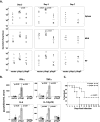Reduced secretion of YopJ by Yersinia limits in vivo cell death but enhances bacterial virulence
- PMID: 18483548
- PMCID: PMC2361194
- DOI: 10.1371/journal.ppat.1000067
Reduced secretion of YopJ by Yersinia limits in vivo cell death but enhances bacterial virulence
Abstract
Numerous microbial pathogens modulate or interfere with cell death pathways in cultured cells. However, the precise role of host cell death during in vivo infection remains poorly understood. Macrophages infected by pathogenic species of Yersinia typically undergo an apoptotic cell death. This is due to the activity of a Type III secreted effector protein, designated YopJ in Y. pseudotuberculosis and Y. pestis, and YopP in the closely related Y. enterocolitica. It has recently been reported that Y. enterocolitica YopP shows intrinsically greater capacity for being secreted than Y. pestis YopJ, and that this correlates with enhanced cytotoxicity observed for high virulence serotypes of Y. enterocolitica. The enzymatic activity and secretory capacity of YopP from different Y. enterocolitica serotypes have been shown to be variable. However, the underlying basis for differential secretion of YopJ/YopP, and whether reduced secretion of YopJ by Y. pestis plays a role in pathogenesis during in vivo infection, is not currently known. It has also been reported that similar to macrophages, Y. enterocolitica infection of dendritic cells leads to YopP-dependent cell death. We demonstrate here that in contrast to Y. enterocolitica, Y. pseudotuberculosis infection of bone marrow-derived dendritic cells does not lead to increased cell death. However, death of Y. pseudotuberculosis-infected dendritic cells is enhanced by ectopic expression of YopP in place of YopJ. We further show that polymorphisms at the N-terminus of the YopP/YopJ proteins are responsible for their differential secretion, translocation, and consequent cytotoxicity. Mutation of two amino acids in YopJ markedly enhanced both translocation and cytotoxicity. Surprisingly, expression of YopP or a hypersecreted mutant of YopJ in Y. pseudotuberculosis resulted in its attenuation in oral mouse infection. Complete absence of YopJ also resulted in attenuation of virulence, in accordance with previous observations. These findings suggest that control of cytotoxicity is an important virulence property for Y. pseudotuberculosis, and that intermediate levels of YopJ-mediated cytotoxicity are necessary for maximal systemic virulence of this bacterial pathogen.
Conflict of interest statement
The authors have declared that no competing interests exist.
Figures






References
-
- Monack D, Falkow S. Apoptosis as a common bacterial virulence strategy. Int J Med Microbiol. 2000;290:7–13. - PubMed
-
- Fu Y, Galan JE. A Salmonella protein antagonizes Rac-1 and Cdc42 to mediate host-cell recovery after bacterial invasion. Nature. 1999;401:293–297. - PubMed
-
- Lin SL, Le TX, Cowen DS. SptP, a Salmonella typhimurium type III-secreted protein, inhibits the mitogen-activated protein kinase pathway by inhibiting Raf activation. Cell Microbiol. 2003;5:267–275. - PubMed
-
- Wren BW. The yersiniae–a model genus to study the rapid evolution of bacterial pathogens. Nat Rev Microbiol. 2003;1:55–64. - PubMed
Publication types
MeSH terms
Substances
Grants and funding
LinkOut - more resources
Full Text Sources
Other Literature Sources

